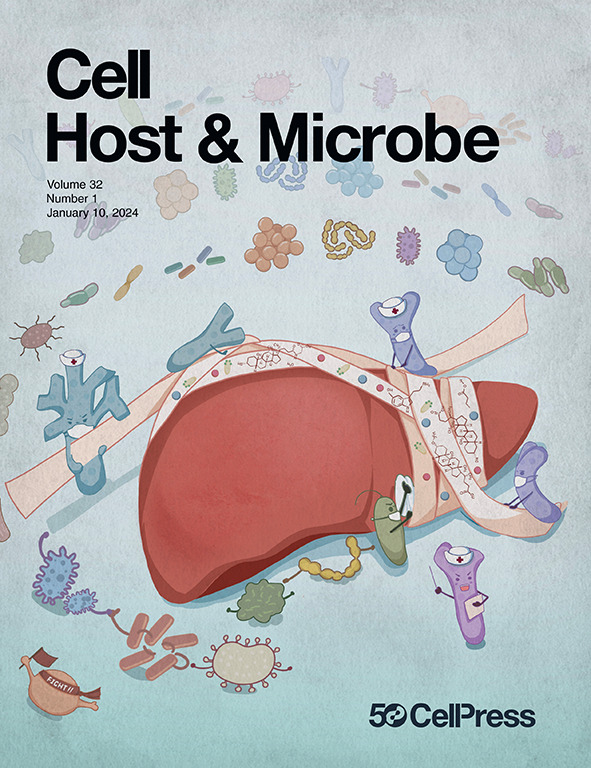Phage arabinosyl-hydroxy-cytosine DNA modifications result in distinct evasion and sensitivity responses to phage defense systems
IF 18.7
1区 医学
Q1 MICROBIOLOGY
引用次数: 0
Abstract
Bacteria encode diverse anti-phage systems, such as CRISPR-Cas and restriction modification (RM), which limit infection by targeting phage DNA. We identified a DNA modification in phages, i.e., 5-arabinosyl-hydroxy-cytosine (5ara-hC), which adds arabinose to cytosines via a hydroxy linkage and protects phage from DNA targeting. The hydroxy linkage was common among arabinoslyated phages, with some arabinosylated phages encoding arabinose-5ara-hC transferases (Aat) that add a second or third arabinose to DNA. DNA arabinosylation enables evasion from DNA-targeting type I CRISPR-Cas and type II RM systems. However, arabinosylated phages remain sensitive to RNA-targeting CRISPR-Cas (type III and VI) and promiscuous type IV restriction endonucleases. 5ara-hC enables evasion of glycosylase defenses that target phages with glucosylated hydroxymethyl cytosines, and 5ara-ara-hC protects against some defenses capable of targeting 5ara-hC-modified phages. Collectively, this work identifies DNA modifications that enable phages to evade multiple defenses yet remain vulnerable to some systems that target RNA or modified nucleobases.

噬菌体阿拉伯糖基-羟基胞嘧啶DNA修饰导致对噬菌体防御系统的明显逃避和敏感反应
细菌编码多种抗噬菌体系统,如CRISPR-Cas和限制性修饰(RM),它们通过靶向噬菌体DNA来限制感染。我们在噬菌体中发现了一种DNA修饰,即5-阿拉伯糖基-羟基胞嘧啶(5ara-hC),它通过羟基连锁将阿拉伯糖添加到胞嘧啶上,并保护噬菌体免受DNA靶向。羟基连锁在阿拉伯糖化噬菌体中很常见,一些阿拉伯糖化噬菌体编码阿拉伯糖-5ara- hc转移酶(Aat),将第二或第三个阿拉伯糖添加到DNA中。DNA阿拉伯糖基化可以逃避DNA靶向I型CRISPR-Cas和II型RM系统。然而,阿拉伯糖基化噬菌体仍然对靶向rna的CRISPR-Cas (III型和VI型)和混杂的IV型限制性内切酶敏感。5ara-hC能够规避糖基化羟甲基胞嘧啶噬菌体的糖基酶防御,并且5ara-ara-hC能够防御一些能够靶向5ara-hC修饰的噬菌体的防御。总的来说,这项工作确定了DNA修饰,使噬菌体能够逃避多种防御,但仍然容易受到一些靶向RNA或修饰核碱基的系统的攻击。
本文章由计算机程序翻译,如有差异,请以英文原文为准。
求助全文
约1分钟内获得全文
求助全文
来源期刊

Cell host & microbe
生物-微生物学
CiteScore
45.10
自引率
1.70%
发文量
201
审稿时长
4-8 weeks
期刊介绍:
Cell Host & Microbe is a scientific journal that was launched in March 2007. The journal aims to provide a platform for scientists to exchange ideas and concepts related to the study of microbes and their interaction with host organisms at a molecular, cellular, and immune level. It publishes novel findings on a wide range of microorganisms including bacteria, fungi, parasites, and viruses. The journal focuses on the interface between the microbe and its host, whether the host is a vertebrate, invertebrate, or plant, and whether the microbe is pathogenic, non-pathogenic, or commensal. The integrated study of microbes and their interactions with each other, their host, and the cellular environment they inhabit is a unifying theme of the journal. The published work in Cell Host & Microbe is expected to be of exceptional significance within its field and also of interest to researchers in other areas. In addition to primary research articles, the journal features expert analysis, commentary, and reviews on current topics of interest in the field.
 求助内容:
求助内容: 应助结果提醒方式:
应助结果提醒方式:


